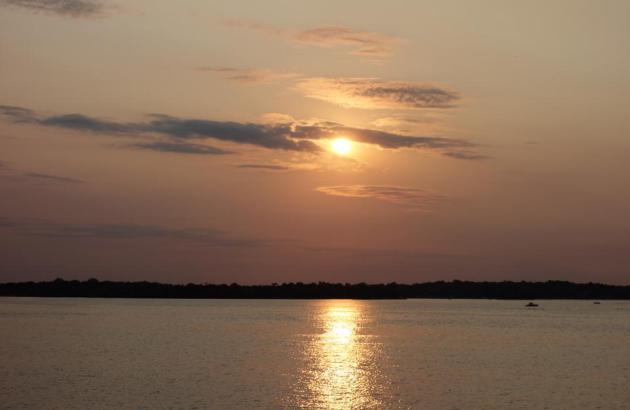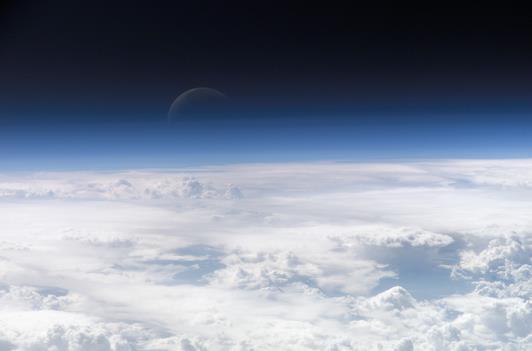61 F. average high on April 24.
67 F. high on April 24, 2016.
April 25, 1996: Heavy snow falls over northern Minnesota, including 10 inches of snow at Baudette. The International Falls Airport is forced to close for only the second time in history.

Cool and Soggy: Extended Outlook Calls for Disruption
"Grandpa, tell me again how people once told other people the weather forecast!" Is this a conversation I'm going to have in 15 years? Will humanoids be optional, computers so powerfully pervasive that meteorologists go the way of Betamax and 8-tracks?
I wish I knew, but there's little doubt all of us will have to adapt to careers of lifelong learning. With robotics, automation and artificial intelligence half of all current white collar jobs may go away.
A century ago 41 percent of Americans were farmers; with mechanization only 2 percent of us farm today. How best to prepare for jobs that don't even exist yet? We need smart strategies that prepare us for these coming (seismic) shifts.
Time for a little atmospheric pay-back after a postcard-weekend. A storm spinning up along the leading edge of chilly air keeps rain overhead from this afternoon into Wednesday; over an inch in some spots. Slushy snow mixes in over far northern counties, and I could even see some slushed-up lawns in the Twin Cities metro by Thursday morning. Whatever snow falls won't stick around for long. A much higher sun angle will see to that.
Saturday almost looks tolerable but a cold rain returns on Sunday. Welcome to a cool, wet pattern. Spring takes a siesta until late next week.
P.S. The excitable guy above? He's my replacement, coming sooner than I'd like. A little robotic in his gestures, but (much) smarter, slower to anger, better attitude, nicer disposition - and he never takes a vacation or asks for a raise. We should switch him over to decaf though. Or remove his battery.

A Sloppy Pattern. Only the southwestern USA and immediate Gulf Coast is getting a break from puddles in the near future. Soaking rains spread into New England, while a storm spins up over the central Plains, spreading a cold rain into Minnesota and Wisconsin, ending as wet snow by Thursday across much of the Upper Midwest. More storms take aim at the Pacific Northwest, a familiar turn of events. 84-hour NAM guidance: NOAA and Tropicaltidbits.com.
Plowable Snowfall Minnesota Arrowhead and Northern Wisconsin? This is 3 KM NAM guidance, hinting at a few inches of slush for much of central Minnesota, especially Wednesday night into early Thursday. The model prints out a cool foot for the North Shore, with slush into the Twin Cities metro. Best chance of waking up to slushy lawns: Thursday morning.
Another Soaker.
Models print out roughly an inch of rain for much of central and
eastern Minnesota later today into Thursday; mostly rain, but with a
potentially slushy aftertaste late Wedneday into Thursday. Map: Aeris
AMP.
Portraits of the Earth-Moon System. The Atlantic has done a terrific job assembling some of the best photos of Earth and the Moon on one web link I've ever seen: "The Earth and its moon almost form a binary planet system. The moon is enormous—relative to the size of its planet—compared with the rest of the solar system. Since the 1960s, spacecraft and astronauts have been able to “step back” far enough to capture combined portraits of the Earth and its moon, separated by some 240,000 miles. Gathered below are some of the best of these portraits, some from as far away as 100 million miles..."
Image credit: NASA DSCOVR satellite. "Earth and the far side of the moon on July 5, 2016, also featuring Typhoon Nepartak over the Pacific Ocean, imaged by NASA’s Deep Space Climate Observatory (DSCOVR) satellite, about 1.5 million km (930,000 mi) from Earth."
This Interactive Map Shows Why Renewables and Natural Gas Are Taking Over the U.S. Here's a snippet from Vox: "This one’s for the energy nerds out there. The University of Texas Austin’s Energy Institute has put out an incredibly useful interactive map
showing what types of power plants are cheapest to build in every
county in the continental United States. (No, really, it’s fascinating.)
Playing around with the map,
you can see why natural gas and renewables are likely to provide much
of America’s new electric capacity going forward. It also shows why, despite Trump’s promises,
it will be extremely difficult to build new US coal plants anytime
soon. And you can explore the effects a carbon tax might have on
America’s grid — or, say, the development of much cheaper nuclear
reactors..."
Image credit: David Gothard.
Kitty
Hawk’s flying car, if you insisted on calling it a “car,” looked like
something Luke Skywalker would have built out of spare parts. It was an
open-seated, 220-pound contraption with room for one person, powered by
eight battery-powered propellers that howled as loudly as a speedboat.
The tech industry, as we are often told, is fond of disrupting things,
and lately the automakers have been a big target. Cars that use
artificial intelligence to drive themselves, for example, have been in
development for a few years
and can be spotted on roads in a number of cities. And now, coming onto
the radar screen, are flying machines that do not exactly look like
your father’s Buick with wings. More than a dozen start-ups backed by
deep-pocketed industry figures like Larry Page,
a Google founder — along with big aerospace firms like Airbus, the
ride-hailing company Uber and even the government of Dubai — are taking
on the dream of the flying car..."
Image credit: "Kitty
Hawk, a Silicon Valley company backed by Larry Page, a Google founder,
began testing a prototype over a lake in Northern California."

Photo credit: AP Photo/Invision/Antonio Pullano.
Photo credit: "Author Robert Pirsig and his son Chris in 1968. Pirsig, who wrote Zen and the Art of Motorcycle Maintenance, died Monday at age 88." William Morrow/HarperCollins.
“Nothing is really ours until we share it.” – C.S. Lewis
March for Science. This is one of my favorite signs, courtesy of Twitter.
TODAY: Dry start. PM rain likely. Winds: NE 10-15. High: 63 (falling by afternoon)
TUESDAY NIGHT: Periods of rain, maybe heavy. Low: 44
WEDNESDAY: Rain mixes with wet snow. Fairly unpleasant. Winds: N 10-15. High: 46 (falling)
THURSDAY: Slushy start? Overcast and chilly, flurries. Winds: NW 8-13. Wake-up: 36. High: 42
FRIDAY: Mostly cloudy, still feels more like March. Winds: NW 8-13. Wake-up: 34. High: 52
SATURDAY: Clouds increase, better day of weekend. Winds: NE 8-13. Wake-up: 36. High: 53
SUNDAY: Chance of rain, fairly raw out there. Winds: NE 10-15. Wake-up: 39. High: 45
MONDAY: Damp start, then slow clearing, getting better. Winds: NW 8-13. Wake-up: 35. High: 58
Climate Stories....
The Earth Just Reached a CO2 Level Not Seen in 3 Million Years. Hey
c'mon - you're hyping this, all you crazy warmists - you alarmists!
People like warm weather - I mean what can possibly go wrong? Here's an
excerpt from ThinkProgress: "...Carbon dioxide in the Earth’s atmosphere, for the first time in modern record-keeping, has surpassed 410 parts per million. Since measurements began in the 1950s at Mauna Loa, atmospheric concentrations of carbon dioxide have increased 42 percent increase
from pre-industrial levels. Children born today will likely never live
in a world with levels below 400 parts per million. The last time Earth
had comparable levels of atmospheric carbon dioxide was about three
million years ago, during the mid-Pliocene. Back then, global average
temperature was about 3.6–5.2°F (2–3°C) warmer than it is today. Sea levels were also higher, by about 15–25 meters..."
Graphic credit: "The Keeling Curve." CREDIT: Scripps Institute of Oceanography.

Record-Breaking Global Climate Events Already Being Shaped by Global Warming, Scientists Find. Here's an excerpt from The Washington Post: "...In a new study,
published Monday in the journal Proceedings of the National Academy of
Sciences, they’ve analyzed the influence of global warming on extreme
climate events, such as record-breaking temperatures or rainfall, all
over the world. And they’ve found that climate change has had a
substantial effect. The study suggests that anthropogenic global
warming, as it has advanced, has had a significant hand in the
temperatures seen during the hottest month and on the hottest day on
record throughout much of the world. It finds that climate change
substantially increased the likelihood of these record warm events
occurring in the first place, and also made them more severe than they
otherwise would have been, in more than 80 percent of the observed
world. “This suggests that the world isn’t yet at a place where every
single record-setting hot event has a human fingerprint, but we are
getting close to that point,” said Noah Diffenbaugh, a climate scientist at Stanford University and lead author of the new paper..."

Science is Disruptive. Clifton Leaf, Editor in Chief at Fortune, had a profound post that caught my eye; here's an excerpt that resonated: "...The
very existence of science is disruptive—because the tool is designed to
undercut belief, to challenge both the sacred and the prosaic. The aim
of science is disprove the comfortable assumptions of life, not to
reinforce them. And since the time of Galileo, it has been seen as a
threatening interloper to those in power and to everyday existence. The
notion of human-caused planetary warming threatens the status quo, no
less than the notion of a solar-centric universe dislodged the
consecrated cosmology of the 17th century. The unavoidable message
today: Governments, businesses, and consumers can’t keep doing what
they’re doing without the risk of having an iceberg float into New York
Harbor. So, too, the latest fruits of science, technology, engineering,
and mathematics—from artificial intelligence to self-driving vehicles to
advanced robotics—threaten existing industries and the people who work
in them even as they promise to create brand new industries and jobs to
replace them..."
Image credit: NASA.
What Americans Really Think About Climate Change. It seems a little like random violence - it will happen to someone else. There's no way it can happen to me! Here's an excerpt from The Atlantic: "...Climate change is a “stuck” issue in American politics. The polling continually points to a larger conclusion: Global warming is a highly partisan issue that most voters do not consider particularly significant to them, personally, even if they are worried about it. A Yale poll from last month put it starkly: More than 50 percent of Americans believe that climate change will “harm people in the United States,” but fewer than 40 percent of Americans believe it will “harm me, personally.” A lot of people know about climate change, and a lot of people think it is generally bad. But they do not change their votes because of it. Americans may change their vote because of economic fear, or defense policy, or to protect their property or social privileges. But they do not vote because the ice caps are melting. This is the heart of the climate issue..." (Image credit: NOAA NCDC).
Rising Seas Will Send Millions of Refugees to Inland Cities.
Alarmist hype? After Katrina struck New Orleans in 2005 400,000 people
fled inland; many never returned. Extreme storms will accelerated the
movement away from water, based on new research highlighted at NexusMedia: "When
rising waters from superstorms like Katrina or Sandy inundate heavily
populated coastal communities, vast numbers of people will abandon their
destroyed homes and flee for safety and shelter elsewhere. Where will
they go — and how will their destination cities cope with them? That’s
the focus of a new study
that projects as many as 13.1 million Americans could become climate
refugees by the end of this century, an influx of people that could
stress inland cities, particularly those already grappling with
population growth, urban development, traffic congestion and water
management. “We typically think about sea-level rise as a coastal issue,
but if people are forced to move because their houses become inundated,
the migration could affect many landlocked communities as well,” said
Mathew Hauer, a demographer at the University of Georgia and author of
the study, published in the journal Nature Climate Change.
“For many inland areas, incorporating climate change scenarios into
their strategic long-range planning would be an appropriate strategy...”
Map credit: "Net changes in population by metropolitan area due to migration from sea-level rise." Source: Nature Climate Change
Photo credit: "Pontchatoula residents flee rising waters in 2016. A new study predicts that thousands of Louisiana residents will be heading to Texas and other states to avoid rising sea levels over the next century." (Photo by Ted Jackson, Nola.com | The Times-Picayune).
Photo credit: Richard at Flickr.
Photo credit: "A rescuer of the Malta-based Migrant Offshore Aid Station carries a migrant baby rescued from a wooden boat in the Mediterranean Sea off the coast of Sabratha in Libya this month." (Darrin Zammit Lupi/Reuters)
More and More Fossil Fuel Companies Support a Carbon Tax - Here's a Running List. Who would have predicted this a year or two ago? Here's an excerpt from Quartz: "...Royal Dutch Shell ($233 billion) “If Trump does not go down the path of a carbon tax, we should not lose our resolve. We should stick to our values as Canadians to do something to protect the environment.” — Michael Crothers, President of Shell Canada, November 2016. “Carbon-pricing systems encourage the quickest and most efficient ways of reducing emissions widely.” — Ben van Beurden, CEO of Royal Dutch Shell, October 2015.
Exxon Mobil ($218 billion) “One option being discussed by policy makers is a national revenue-neutral carbon tax. This would promote greater energy efficiency and the use of today’s lower-carbon options, avoid further burdening the economy, and also provide incentives for markets to develop additional low-carbon energy solutions for the future.” — Darren Woods, CEO of Exxon Mobil, February 2017..."
Photo credit: "Stopping the tragedy of the commons." (Reuters/Edgar Su)
Photo credit: "U.S. Rep. Brian Fitzpatrick (R-PA), with Greg Goldman (L), executive director of Audubon Pennsylvania, tries to spot a red-winged blackbird while on a birdwatching tour hosted by the Audubon Pennsylvania in New Hope, Pennsylvania, U.S., April 22, 2017." REUTERS/Emily Flitter.


Solar-Powered Sermon. I want to thank Reverend Sarah Campbell the good people of Mayflower Church in South Minneapolis for their warm welcome and words of hope and encouragement. I gave the sermon yesterday, which was a first, a humbling undertaking at that. I presented the biblical case for climate justice, clean air, water and land; how we are all called to be stewards of God's Creation. Mayflower Church installed solar panels 6-7 years ago - and a rough back-of-the-envelope calculation suggests a 20% savings on their electrical bill, to date. They are ahead of the curve, but when other churches discover they can save considerable money I suspect this clean, renewable-energy success story will multiply. Thank you!
Scientists: Get Used to Wildfires in a Warming World. Here's a clip from a story at Climate Central: "...Yet homes and even whole communities still go up in flames, and there’s little indication that many efforts to reduce the risk have done much good, the study says. “Neither suppression nor current approaches to fuels management adequately reduce vulnerability of communities to increasing wildfire,” said the study’s lead author, Tania Schoennagel, a research scientist at the University of Colorado-Boulder’s Institute of Arctic and Alpine Research. “We’ve been very effective with fire suppression for many years, but wildfires are increasing beyond our capacity to control, especially with more people in fire’s way." Park Williams, a bioclimatologist the Lamont-Doherty Earth Observatory at Columbia University, said the paper makes a valuable point: Forest density and climate change have converged to vastly increase catastrophic wildfire frequency and size in a way a that is entirely out of human control..."
Photo credit: "The 2016 Fort McMurray wildfire in eastern Alberta." Credit: The Premier of Alberta/flickr.
No comments:
Post a Comment